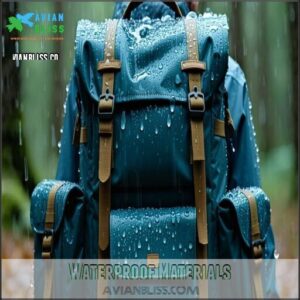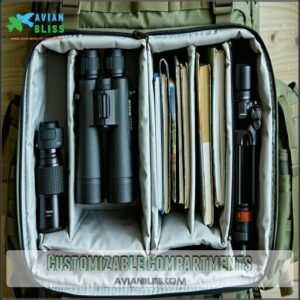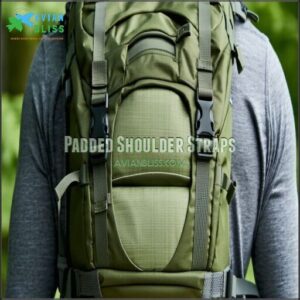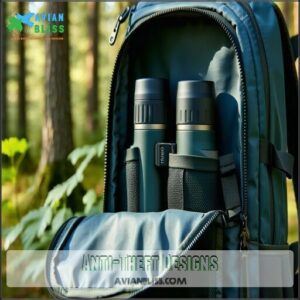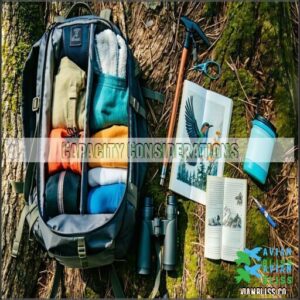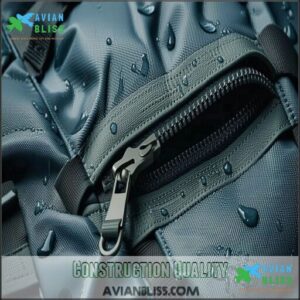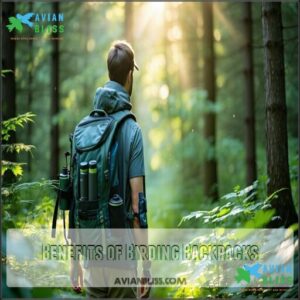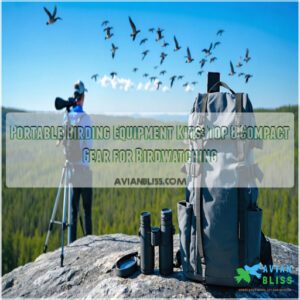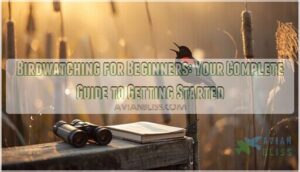This site is supported by our readers. We may earn a commission, at no cost to you, if you purchase through links.
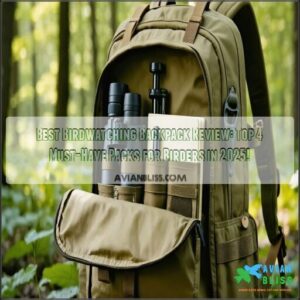
Our best birdwatching backpack review identifies models with quick-access compartments, weather resistance, and specialized tripod holders as top performers.
Look for adjustable dividers that cradle binoculars and field guides while distributing weight evenly across your shoulders.
The most effective designs feature waterproof materials and padded sections that prevent equipment jostling when you’re racing to spot that elusive warbler.
Beyond these basics, subtle differences in organization systems and harness designs can markedly impact your field experience.
Table Of Contents
- Key Takeaways
- Birding Backpack Essentials
- Choosing Birdwatching Backpacks
- Top 4 Birdwatching Backpacks
- Benefits of Birding Backpacks
- Selecting The Best Birdwatching Backpack
- Frequently Asked Questions (FAQs)
- Which are the best backpacks for birding?
- Is it necessary to use a backpack for birding?
- What features make a good bird backpack?
- What are the benefits of a Bird backpack?
- Are bird carrying backpacks safe?
- Why is a bird carrying backpack a good investment?
- How do birding backpacks affect spotting efficiency?
- Are lightweight backpacks durable enough for fieldwork?
- Which backpacks offer silent opening mechanisms?
- Can backpacks accommodate spotting scopes securely?
- Conclusion
Key Takeaways
- You’ll need a backpack with waterproof materials and anti-theft features to protect your valuable birding equipment from unpredictable weather and potential theft while in the field.
- Your ideal birding backpack should have customizable compartments with adjustable dividers that keep your binoculars, field guides, and other gear organized and quickly accessible when spotting rare birds.
- Look for comfort features like padded shoulder straps, breathable mesh backing, and proper weight distribution systems that prevent fatigue during long birding expeditions.
- Consider the capacity based on your trip duration—20-30 liters works for day trips, while longer excursions require 25+ liters to accommodate extra gear and supplies.
Birding Backpack Essentials
You’ll need a backpack with waterproof materials, customizable compartments, padded straps, and anti-theft features to protect your valuable birding equipment in various field conditions.
Your ideal birding companion combines practical functionality with comfort, ensuring you can focus on spotting that elusive warbler rather than struggling with an inadequate pack that leaves your binoculars exposed to rain or your shoulders aching after a morning’s expedition with customizable compartments.
Waterproof Materials
Braving the elements while birdwatching demands gear that won’t leave you—or your equipment—soaked. Waterproof materials are essential for any birding backpack, with waterproof ratings ranging from water-resistant to fully submersible.
- Look for high-denier ripstop nylon with DWR treatments for superior weather resistance
- Check for proper seam sealing, which prevents moisture from penetrating stitching areas
- Always choose backpacks with an included rain cover for additional protection during downpours
For reliable protection, consider a specialized birding pack.
Customizable Compartments
Customization is the key to an efficient birding backpack.
With adjustable dividers, you’ll keep your gear organized and accessible.
Customizable compartments let you adapt your backpack to specific equipment needs and prevent items from shifting during hikes.
Many birders find it useful to purchase backpack divider products for ideal organization.
| Compartment Type | Gear Organization | Customization Benefits |
|---|---|---|
| Divider System | Separates optics from accessories | Prevents damage between items |
| Side Pockets | Quick access to field guides | Keeps reference materials handy |
| Padded Inserts | Protects cameras and binoculars | Adjustable for different equipment |
| Top Compartment | Stores personal items separately | Maintains organization during use |
| Accessory Loops | Secures tripods and water bottles | Frees internal storage space |
The use of a divider system and side pockets can greatly enhance the customization benefits of a birding backpack, allowing for quick access to necessary items and preventing damage to equipment.
This efficient design helps birders to stay organized and focused on their observations.
Padded Shoulder Straps
While customizable compartments keep your gear organized, the real comfort comes from properly padded shoulder straps.
Your birdwatching backpack needs quality shoulder straps with breathable padding to prevent shoulder fatigue during long birding sessions.
Ergonomic design and strap adjustability guarantee proper weight distribution across your upper body.
Look for thick foam or gel padding that conforms to your shoulders—your back will thank you after hours of spotting that elusive warbler.
Anti-Theft Designs
While comfortable shoulder straps keep you going, protecting your valuable birding gear is equally important.
Anti-theft designs in quality birdwatching backpacks offer peace of mind when you’re focused on that rare species.
Modern backpacks feature:
- Lockable zippers preventing unauthorized access
- Hidden pockets for storing valuables away from prying eyes
- RFID protection shields that block electronic theft
- Slash-resistant materials that deter cut-and-run thieves
These safety features guarantee your birding gear remains secure throughout your adventures.
Consider also that many birders find compact binoculars essential for easy portability.
Choosing Birdwatching Backpacks
You’ll need to take into account capacity, construction quality, and comfort features when selecting a backpack that properly accommodates your binoculars, field guides, and other birding essentials.
The right birding backpack balances storage space with comfort, ensuring you can carry your gear efficiently through various terrains without strain during those long observation sessions, which is crucial for a comfortable birding experience.
Capacity Considerations
When selecting your best birding backpack, size truly matters. For day trips, 20-30 liters provides sufficient storage capacity without weighing you down.
Multi-day excursions require 25+ liters to accommodate extra layers and supplies. Remember that capacity measurements include all pockets, so consider gear volume and weight limits carefully.
Your bird watching bag should match your trip duration and hydration needs while allowing for pack expansion when necessary.
Construction Quality
The backbone of any birding gear backpack lies in its construction quality.
Ripstop nylon offers superior material durability and tear-resistant properties while remaining lightweight.
Check stitching strength at stress points—double or bar-tack stitching prevents premature failure.
Zipper quality matters; YKK zippers won’t fail mid-expedition.
Evaluate frame integrity and weather resistance to guarantee your optics stay protected during unexpected downpours.
Comfort Features
While robust construction forms the foundation of a quality birding backpack, your comfort during long days in the field matters just as much.
Look for padded straps that won’t dig into your shoulders and breathable mesh backing that prevents sweaty discomfort.
Adjustable torso lengths accommodate different body types, while hip belts transfer weight from your shoulders to your hips.
Proper lumbar support can make the difference between an enjoyable outing and a painful experience, ensuring a comfortable backpacking trip with breathable mesh.
Top 4 Birdwatching Backpacks
You’ll find the perfect balance of functionality and comfort in our carefully selected top 4 birdwatching backpacks for 2025.
These packs offer essential features such as waterproof materials, customizable compartments, and padded support that you need for successful birding expeditions.
1. BAGSMAR Camera Backpack for Photographers
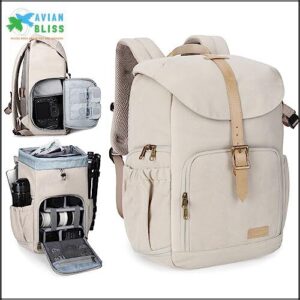
Designed with versatility in mind, the BAGSMAR Camera Backpack offers impressive functionality for birders who carry photography equipment.
Its customizable compartments with five padded dividers keep your gear secure while the side access design allows quick retrieval of your camera when that rare species appears.
The waterproof canvas construction protects against unexpected weather, and the included rain cover provides additional security.
At under $65, this affordable pack includes a padded laptop compartment and anti-theft features like lockable zippers.
For capturing distant birds, consider a telephoto lens essential.
Despite its compact appearance, users consistently report it holds an impressive amount of equipment.
Best For: Photographers and birders needing a durable, affordable backpack to safely transport and access their camera equipment on trips.
- Main compartment may not comfortably fit larger lenses.
- Bag can become front-heavy and fall forward when placed on the ground.
- Magnetic buckle on the top flap may wear out over time.
- Customizable compartments securely organize camera gear.
- Durable waterproof canvas with an included rain cover.
- Affordable pricing under $65 with impressive storage capacity.
2. Osprey Daylite Plus Backpack Previous
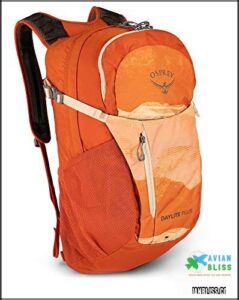
While exploring trails in search of rare birds, you’ll appreciate the Osprey Daylite Plus Backpack’s 20-liter capacity.
This versatile pack features a padded laptop sleeve that fits devices up to 15 inches, perfect for storing field guides or tablets.
The mesh-covered foam back panel guarantees comfort during long birding sessions, while dual stretch mesh side pockets hold water bottles or compact binoculars.
Its lightweight design (16 ounces) won’t weigh you down, and the front shove-it pocket provides quick access to rain gear when storms approach.
The sustainable materials meet bluesign approval for environmentally conscious birders.
Best For: Day hikers, travelers, and commuters seeking a lightweight, versatile backpack with ample organization and comfort.
- Side pockets struggle to fit larger water bottles.
- Backpack does not stand upright on its own.
- Waist strap placement may be uncomfortable for taller users.
- 20-liter capacity with padded laptop sleeve for devices up to 15 inches.
- Lightweight at 16 ounces and made with sustainable materials.
- Comfortable mesh-covered foam back panel for extended use.
3. Hydro Flask Black Wide Mouth 32oz
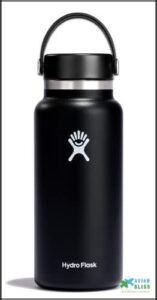
While a Hydro Flask isn’t technically a backpack, this 32oz wide mouth bottle will gear up any birder’s kit.
Constructed from professional-grade stainless steel, it keeps water cold for 24 hours or coffee hot for 12 hours—perfect for those dawn-to-dusk birding expeditions.
The leakproof Flex Cap with flexible strap secures easily to your backpack, while the wide mouth accommodates ice cubes and simplifies cleaning.
BPA-free materials guarantee your drinks stay pure with no flavor transfer between uses, and its durable design withstands field conditions without denting, making it an essential companion for any serious birder.
Best For: Outdoor enthusiasts, birders, and anyone needing reliable all-day hydration.
- Slightly less insulating efficiency in smaller sizes.
- No straw option, which may not suit all preferences.
- Higher upfront cost compared to some alternatives.
- Exceptional insulation keeps drinks hot or cold for extended periods.
- Durable construction stands up to tough conditions and daily use.
- Wide mouth design makes it easy to fill, clean, and add ice.
4. Larabar Peanut Butter Chocolate Chip Bars

Fuel for your feathered friend quest, Larabar Peanut Butter Chocolate Chip Bars provide essential energy during long birding expeditions.
Made from just four simple ingredients—dates, peanuts, chocolate chips, and sea salt—these vegan, gluten-free bars offer a clean energy source without artificial additives.
Each 1.6 oz bar delivers a balanced mix of carbohydrates, healthy fats, and protein to sustain your energy while spotting rare species.
Their convenient individual wrapping makes them ideal for tucking into backpack pockets, and at $1.75 per bar, they’re a worthwhile investment in your birding stamina, providing essential energy.
Best For: Health-conscious individuals seeking a vegan, gluten-free, and on-the-go snack with clean ingredients.
- Premium pricing at $1.75 per bar may deter some buyers.
- Contains peanuts, not suitable for individuals with allergies.
- Back-ordered with a 10-15 day waiting period for shipping.
- Made with 100% real, simple ingredients.
- Vegan, gluten-free, dairy-free, and Kosher.
- Perfect for quick energy during busy days or activities.
Benefits of Birding Backpacks
You’ll experience significant advantages with a dedicated birding backpack, from keeping your binoculars and field guides protected from unexpected rain to accessing your camera quickly when that rare warbler appears.
A quality birding pack distributes weight evenly across your shoulders and back, allowing you to spend hours in the field without the neck strain and fatigue that come from carrying equipment in standard bags, which can be a significant issue for birders who are out for long periods.
Protection From Weather
Now that you’ve seen our top picks, let’s talk about their weather protection capabilities.
Your birding backpack’s weather resistance is non-negotiable. Water-repellent ripstop fabrics and material waterproofing keep your optics safe during sudden downpours.
Most quality packs include a built-in rain cover for complete gear protection. When selecting your pack, consider your local climate conditions—desert birders need different protection than rainforest enthusiasts.
Organization and Accessibility
Beyond weather protection, a well-organized birding backpack saves precious moments when spotting rare species.
The best birdwatching backpack features include:
- Strategic pocket placement for quick access to field guides and notebooks
- Customizable dividers to secure binoculars and camera gear
- Interior layouts with dedicated spaces for different-sized equipment
- Accessible compartments that open quietly to avoid startling birds
Your gear arrangement can make the difference between capturing that perfect shot or missing it entirely, which is why having a backpack with strategic pocket placement and customizable dividers is crucial for quick access to your equipment.
Enhanced Comfort
While organization helps you access your gear, comfort guarantees you can bird for hours without strain.
Organization unlocks efficiency, but comfort transforms a birding trip from endurable to extraordinary.
Quality birding backpacks prioritize your body’s needs during long treks.
| Comfort Feature | Benefit | Ideal For |
|---|---|---|
| Padded Straps | Reduces shoulder fatigue | All-day excursions |
| Back Ventilation | Prevents sweating | Hot weather birding |
| Adjustable Torso | Customizes to your body | Various body types |
| Hip Belt | Transfers weight to hips | Heavy equipment loads |
| Lumbar Support | Maintains proper posture | Extended field trips |
A comfortable birding backpack distributes weight evenly across your body.
The waist belt and chest strap work together to stabilize your load, preventing the painful shoulder dig that can cut your birding short.
Safety and Security
While comfort keeps you going on long birding trips, safety shouldn’t take a back seat.
Today’s birding backpacks offer theft prevention features like lockable zippers and hidden pockets for your valuables. Secure storage compartments protect expensive optics and electronics from damage.
Many packs include waterproof covers for sudden downpours and visibility gear for emergencies. You’ll also find wildlife encounter essentials like bear spray holders—because spotting birds shouldn’t mean becoming part of the food chain!
To guarantee clear views, consider using multi-coated lenses for peak performance.
Selecting The Best Birdwatching Backpack
You’ll need to take into account your specific birding habits, including trip duration and gear requirements, when selecting a backpack that properly balances capacity and comfort.
Your ideal pack should include waterproof materials to protect equipment in unpredictable weather conditions, along with customizable compartments that keep binoculars, field guides, and personal items securely organized during your outdoor observations.
Considering Distance and Time
When selecting the best birding backpack, trip duration and terrain difficulty substantially influence your choice.
For short trips under five miles, a lightweight birding daypack (8-26L) works perfectly.
Longer excursions demand larger pack sizes (35-45L) with stiff frames for proper support.
Consider your hydration needs carefully—extended birding requires at least 2-3 liters of water.
The ideal comfortable birding backpack balances gear weight against the time you’ll spend wearing it.
Evaluating Gear and Equipment
With your trip duration sorted, it’s time to assess what you’ll carry.
Your birding gear determines your ideal backpack capacity. Take inventory of everything: binoculars (consider optical quality and weight), field guides, camera equipment, and personal items.
A thorough gear list helps you match your load to appropriate backpack features. Material durability becomes critical when protecting expensive equipment from the elements.
Consider essential birding backpack options for organized storage. Smart budget allocation means prioritizing features that protect your birdwatching investment.
Prioritizing Comfort and Support
Why compromise on comfort during your birding adventures? Your back deserves protection on those long observation days.
When selecting a birding backpack, prioritize ergonomic design and proper weight distribution. Look for adjustable straps that accommodate your torso length, plus chest straps and waist belts that transfer weight off shoulders.
Breathable materials prevent overheating—particularly important when you’re waiting patiently for that elusive species to appear. A sturdy backpack helps organize essential birding gear for easy access, ensuring you have all your birding gear within reach, making your adventure more enjoyable with a well-organized and proper weight distribution.
Frequently Asked Questions (FAQs)
Which are the best backpacks for birding?
You’ll need water-resistant backpacks with padded straps and multiple compartments.
Osprey Stratos/Sirrus 36L and Patagonia Refugio 26L offer ideal storage for binoculars, field guides, and water.
For longer trips, consider 35-45L packs with stiff frames, which can provide the necessary support and storage.
Is it necessary to use a backpack for birding?
Like a bird without wings, you’ll find birding without a backpack challenging.
While not strictly necessary for brief outings, you’ll want one for longer trips when carrying binoculars, field guides, water, and snacks.
What features make a good bird backpack?
A good bird watching backpack offers waterproof materials, padded straps, customizable dividers for organizing gear, quick-access compartments for binoculars, and plenty of pockets for field guides and water bottles.
What are the benefits of a Bird backpack?
Imagine spotting a rare warbler while your gear stays perfectly organized.
You’ll enjoy hands-free birding, protected equipment from weather, comfortable weight distribution, quick access to binoculars.
And specialized compartments for field guides and water, allowing for a more efficient and enjoyable birding experience with quick access to all your necessities.
Are bird carrying backpacks safe?
There’s a misunderstanding here.
The topic is about backpacks for birdwatchers to carry equipment, not for carrying birds.
You’ll find these specialized backpacks offer safe, comfortable storage for your binoculars, field guides, and other birding essentials.
Why is a bird carrying backpack a good investment?
A bird carrying backpack is worth its weight in gold. You’ll enjoy hands-free birding while protecting your gear and maintaining quick access to essentials like binoculars, field guides, and water.
How do birding backpacks affect spotting efficiency?
A well-organized birding backpack improves your spotting efficiency by keeping gear accessible and distributed comfortably.
You’ll spend less time rummaging and more time observing when equipment is readily available at critical moments.
Are lightweight backpacks durable enough for fieldwork?
Yes, today’s lightweight backpacks often use ripstop nylon and reinforced stitching that withstand field conditions.
You’ll find many models balance minimal weight with durability features like water-resistant coatings and strengthened stress points.
Which backpacks offer silent opening mechanisms?
Look for backpacks with ultra-quiet YKK Vislon zippers or Silent Secure closures. You’ll find these features in the Suppression Silent Pack, which uses roll-top enclosures for stealth in the field.
Can backpacks accommodate spotting scopes securely?
Just as a kangaroo securely carries its young, many specialized birding backpacks include adjustable straps and dedicated compartments.
That’ll hold your spotting scope firmly, preventing movement while allowing quick access when needed, is a key feature of these backpacks, making them ideal for birdwatching enthusiasts who value convenience.
Conclusion
Like binoculars focusing on a distant hawk, your choice of backpack sharpens your entire birding experience.
Armed with our best birdwatching backpack review, you’re now equipped to select the perfect companion for your adventures.
Whether you prioritize weather protection, quick access, or comfort during long treks, you’ll find the right balance of features.
Remember, a quality birding backpack isn’t just carrying gear—it’s freeing you to focus on the skies and the wonders they hold, which is the ultimate goal of a birding experience.
- https://www.amazon.com/BAGSMART-Waterproof-Photographers-Photography-Compartment/dp/B07WDVWL72
- https://ewoodsphoto.com/2021/08/27/camera-bag-review-bagsmart-dslr-backpack/
- https://www.youtube.com/watch?v=91ZCO7ejGVc&pp=ygUXI2JhZ3NtYXJ0Y2FtZXJhYmFja3BhY2s%3D
- https://www.thephoblographer.com/2020/05/26/less-than-65-and-great-the-bagsmart-camera-backpack-review/
- https://onetechtraveller.com/bagsmart-new-york-camera-backpack-review/

